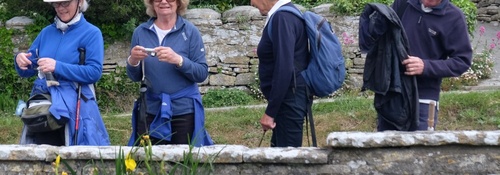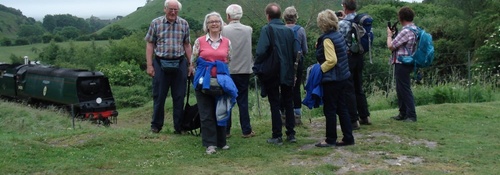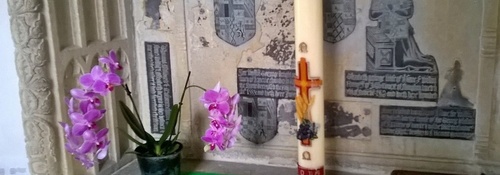Gallery (Click on titles!)
Viewing galleries from June, 2016
Lulworth Cove holiday Day 3

We started in the ancient viilage of Worth Matravers, home of the Square and Compass Inn, where cider is brewed out the back. Food is limited to delicious homemade pies and pasties and this alehouse has not got around to having fancy bars, so all food and drinks is served through a hatch. Earlier customers have been physicist and astronomer Sir Bernard Lovell and nobel laureates Sir Alan Hodgkin and Sir Martin Ryle who were busy developing radar on the nearby cliffs from 1940 to 1942.
In the churchyard nearby are buried Benjamin Jesty and his wife. Many years earlier, in 1774, Benjamin innoculated his wife and sons with cowpox to ward off smallpox. It worked, but he failed to spread the news, especially as some of the locals feared his family would grow horns. Twenty year later Edward Jenner had the same idea, got a better publicity agent and was handsomely rewarded.
Similarly impressive was the walk that some Midhurst folk did recently. We started in the village, inspected the local cattle for pox, then headed seaward. Some then chose an easier route to St Aldhelm's Head whilst others headed fo the beautifully shaped Chapmans Pool and the cliff walk. There is part of this South West Coast Path that should be called the South West Coast Steps. It is a precipitous descent of 180 feet followed by a similar ascent to St Adhelm's Head - very tiring!! The Head is home to the 12th century St Adhelm's Chapel and a lookout station manned by volunteers of the National Coastwatch Institution. From there we travelled along the coast path to the remains of the Winspit Quarry, occasionally home to Dr Who film crews. The return to Worth Matravers was well rewarded with refreshments in the garden of the Square and Compass and no-one felt quite able to walk in the afternoon to the nearby Dancing Ledges. Another time perhaps. Thanks to Marian and Peter for additional photos.
Lulworth Cove holiday Day 2

Swanage Railway steam engines leave Corfe Castle twice a year to link up with MV Balmoral, which then sails from Swanage to view the coast as far as Lulworth Cove, so 5 of us chose that option. The alternative was to walk the 6 miles (560ft gain) from Corfe Castle along the Purbeck Way, then hope the train would stop for us at Herston Halt to take us back to Corfe Castle. That all worked but unfortunately the fog out at sea very much spoilt the view for the sailors. On land, conditions were fairly good, with a little cloud on top of the hill. Thanks to Marian and Peter for additional photos.
In the 1640s, England was in the grip of civil war and Corfe Castle found itself on the front line of conflict between Parliament and King Charles I. The castle had recently been acquired by staunch Royalists, the Bankes family. When war broke out in 1642, the formidable Lady Mary Bankes made it her home while her husband Sir John was away serving the King. Within a year, almost all of Dorset came under the control of Parliament but Corfe stood firm. In 1643, Lady Mary and a garrison of just 80 soldiers saw off a six-week siege. When Sir John died in December 1644, Corfe Castle was the last remaining Royalist stronghold between London and Exeter. Pressure increased during 1645 and by October the castle was again under siege – this time by a larger and more determined enemy force. An officer of her garrison sealed the castle’s fate with an act of treachery when he allowed enemy troops disguised as reinforcements to enter. Lady Mary was forced to surrender after 48 days under siege, but was allowed to keep the seals and keys of the castle in recognition of her courage.
Parliamentarian sappers set to work with gunpowder to reduce the castle to the ruin we see today and the Bankes’ estate was seized. However, Lady Mary had the last laugh. She lived to see her estate returned and the restoration of the monarchy in 1660. This information thanks to www.nationaltrust.org.uk
Duncton via Sutton to Barlavington 15th June

Last Wednesday's walk was very good. Nigel, Kate, Jean and Den walked from Duncton via Sutton and Barlavington Fishery and ended up at the Cricketers in Duncton. Thanks for all the photos, Denis!
Passed by St Richards Church, 11th century. Inside is a painting, info as follows:-
East splay of the north nave window. A robed female saint crucified upside down on a diagonal cross, probably early C16. It has been suggested that this depicts St Wilgefortis (possibly derived from virgo fortis) who is known by a variety of popular names throughout Europe - St Uncumber in England. According to legend, she was a Christian Sicilian or Portuguese princess around 130AD who refused to marry the man chosen by her father as she wished to become a nun. Her father had her cast into prison, where she prayed to be made so unattractive that no man would marry her. Her wish was granted and she grew a beard, which so enraged him that he ordered her to be crucified like Christ, whose heavenly bride she aspired to be.
Thanks to http://www.sussexparishchurches.org/
That's really taking discipline much too far....
Lulworth Cove holiday Day 1

Tyneham village was taken over by the Army in WW2 and hasn't yet been returned. It just happens to be in the vast MOD ranges used for gunnery practice. Only on some weekends is access permitted, so some of us chose to explore the village and look at some very interesting history, whilst the others walked the surrounding hills. We all met for a sandwich lunch on the beach. The hill walkers covered over 8 miles and climbed 1100 feet, the high humidity and a map reading error didn't help! However we all survived and managed some refreshment before the evening meal. Thanks to Marian, Jane and Peter for additional photos.
Tyneham Dorset's Lost Village Tyneham is a small village nestling in the valley below Whiteway Hill. However, it is no ordinary village, but one where time has stood still except for the ravages of time, which have taken their toll. For Tyneham was once a populated village, the villagers living their daily lives without thought of what one day was going to happen. The Second World War came and although Tyneham was not a place likely to be targeted by bombs, the Ministry of Defence targeted it instead. The villagers were told to leave their homes in order that the army could take over the land for the duration of the war. They were promised their homes back at such time as the war ended, but in the event, they never got to live in their homes again. It is still to this day M.O.D. land as indeed it is all around the area. Access to Tyneham is only when the M.O.D. allow, mainly at weekends, when there is no practice firing on the ranges. Now the little village lies in ruins except for the church and old schoolhouse that has been preserved as it was left all those years ago. The names of the pupils are still there with their coat pegs, their work still on the old desks. A walk out of the village leads to the ruins of Tyneham Farm and the old farmlands where sheep still graze. Turning right and following the path for about 3/4 of a mile, passing the ruins of Sea Cottage, leads to a secluded beach at Worbarrow Bay. The beach is rocky with shingle leading to sand. The water is very clear, almost transparent. Thanks to http://www.weymouth-dorset.co.uk/ for this information.
Pulborough, Parham and Cootham Day walk 7.6.2016

Marian, Maddie, June and Linda's day walk started from the car park of the generous White Horse pub. It was a warm day and humid as well but fortunately we were near water during the morning. The afternoon was warm as well and we were very grateful for the shade! 8.1/2 miles, but mostly flat and easy going. Full of interest with the Pulborough Brooks RSPB reserve, the Wiggonholt church, Parham Estate and the airfield at Parham with gliders on tow lines. Very interesting walk, with a great lunch in Cootham at the Crown Inn. Thanks for additional photos from Marian.
Wiggonholt Church was built originally to serve the shepherds and farmers who occupied the area. It is relatively unspoilt, the churchyard being left wild for the first part of the year to encourage wild flowers. Lots of orchids. The wooden bench outside is a recent addition, not without some protests. The Parochial Church Council gained approval from Chichester in spite of 15 different reasons why it shouldn't be there - here are the first 5 reasons:-
i. that the PCC was divided and not unanimous in its decision, and that a differently constituted PCC had come to the opposite view;
ii. that there has been no request for the installation of a seat in living memory;
iii. that there are plenty of seats in the contiguous RSPB reserve;
iv. that the proposal is merely pandering to the wishes of the widow of someone recently buried in the churchyard. Neither she nor her late husband had any involvement with the church;
v. that previous requests of a similar nature have not been pursued because they failed to secure the support of the then incumbent and churchwardens;
However, It's a nice bench and well worth visiting, as is the church.
Recent galleries
- Winchester walk on 26th november 2025
- Stedham walk on 19th November 2025
- Farnham walk on 12th November 2025
- Amberley Walk on 5th November 2025
- Redford and AGM walk on 29th October 2025
History
2025
- November (4)
- October (5)
- September (4)
- August (4)
- July (5)
- June (4)
- May (5)
- April (4)
- March (5)
- February (3)
- January (4)
2024
- December (3)
- November (5)
- October (4)
- September (4)
- August (4)
- July (4)
- June (5)
- May (5)
- April (5)
- March (5)
- February (5)
- January (4)
2023
- December (3)
- November (6)
- October (5)
- September (5)
- August (3)
- July (4)
- June (6)
- May (5)
- April (4)
- March (5)
- February (4)
- January (4)
2022
- December (4)
- November (5)
- October (5)
- September (3)
- August (4)
- July (6)
- June (11)
- May (4)
- April (5)
- March (4)
- February (5)
- January (4)
2021
2020
- December (4)
- November (1)
- October (5)
- September (4)
- August (3)
- July (3)
- March (2)
- February (5)
- January (3)
2019
- December (2)
- November (5)
- October (4)
- September (3)
- August (4)
- July (4)
- June (11)
- May (5)
- April (4)
- March (3)
- February (5)
- January (5)
2018
- December (2)
- November (4)
- October (4)
- September (5)
- August (4)
- July (3)
- June (5)
- May (8)
- April (4)
- March (4)
- February (5)
- January (3)
2017
- December (3)
- November (5)
- October (3)
- September (4)
- August (4)
- July (4)
- June (11)
- May (4)
- April (4)
- March (3)
- February (4)
- January (5)
2016
- December (3)
- November (4)
- October (5)
- September (4)
- August (3)
- July (6)
- June (11)
- May (4)
- April (5)
- March (3)
- February (10)
- January (2)
2015
2014
- June (2)
1997
- February (1)